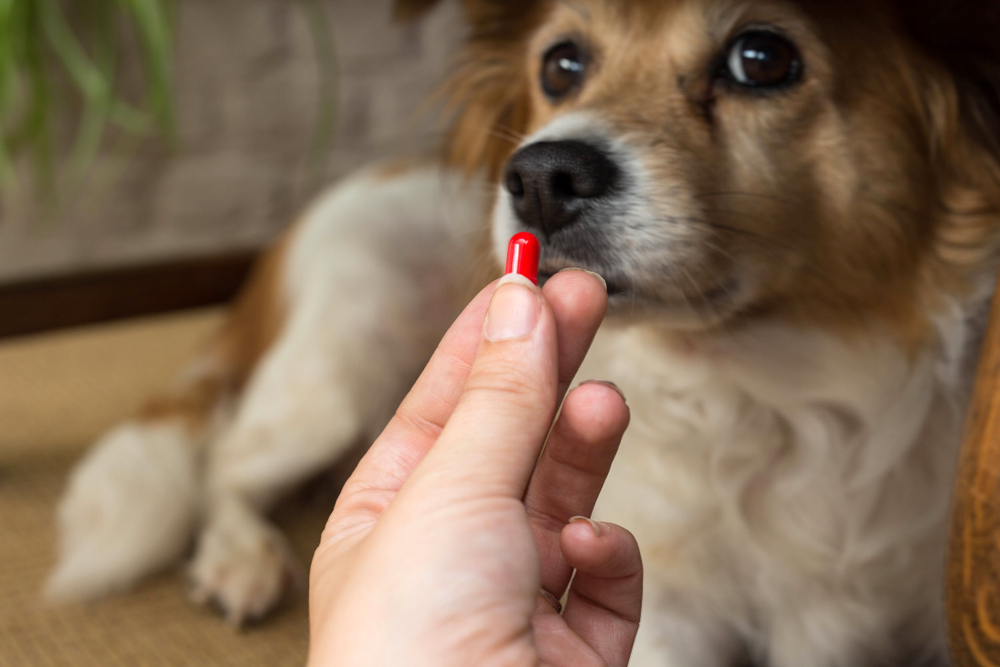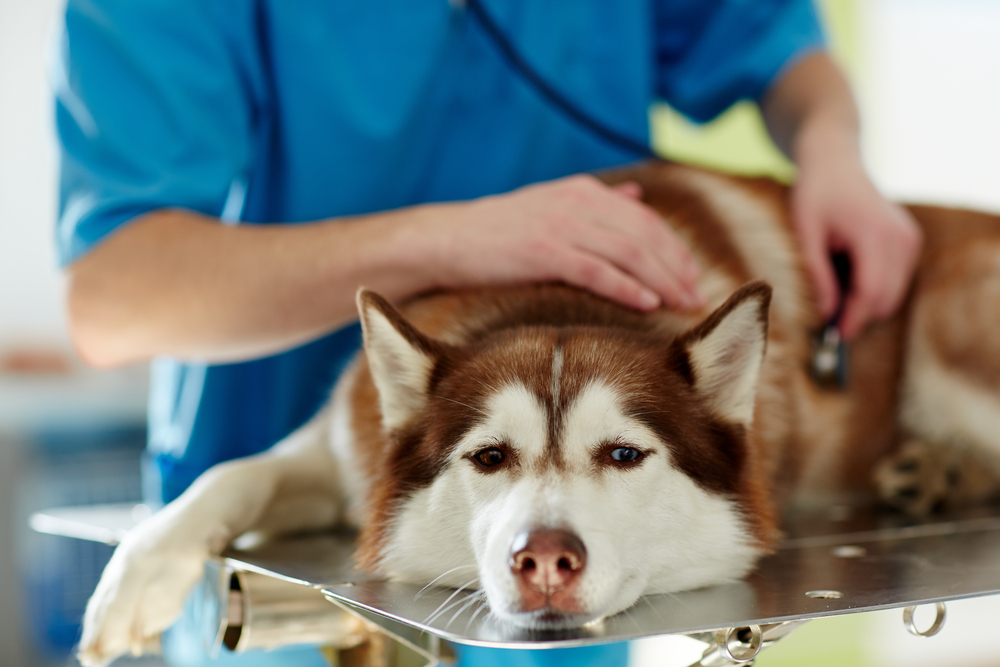Benadryl Overdose In Dogs: Our Vet Discussed 5 Signs & What To Do Next

You may be aware that there are a few human medications that can be given to dogs, however, this should NEVER be done without first checking the safety and dosage with your vet. Dogs metabolize medications very differently to humans, which can mean that they are a lot more sensitive to some, and need higher doses of others.
Benedryl is one such medication that can be given to dogs to help with allergies and motion sickness. Although it can often be challenging to convince your dog to take medication, some liquids and tablets, particularly those flavored for children, can prove to be tempting to our canine friends, so you may find yourself in a situation where your dog has (or you suspect has) taken too much Benadryl.
The first thing to do is not panic. In most cases, taking a higher dose, even a double dose, will be fairly well tolerated, provided it is a one-off event. However, in high enough doses, this medication has the potential to cause serious illness, even death.
Your first point of contact should always be a vet or pet poison hotline. If it is outside regular hours, do not delay getting advice and treatment. There will always be an emergency phone contact out of hours, or you can speak with a vet online.
Keep reading for more information about how much Benedryl is too much, what to look out for in the event of an overdose, and what steps you need to take next.


What Is Benadryl
Benadryl is the most common brand name for the drug Diphenhydramine hydrochloride, an H1 (histamine-1) antagonist that blocks the action of histamine, alleviating allergic reactions such as pruritus (itching), redness, and urticaria (skin rash). One of the most common side effects of diphenhydramine reported by humans is drowsiness, but this effect varies in intensity in dogs.
Oral Benadryl comes in tablets, gel capsules, chewable tablets, and oral liquids.
Is Benadryl Safe For Dogs?
The safety of any medication will depend on the age, breed, and health status of each individual animal, which is why veterinary advice is always advised before giving your pet any medication that hasn’t been specifically prescribed for them, particularly when using human medication.
💛 🐶 Speak To a Vet Online From the Comfort of Your Couch!


If you need to speak with a vet but can’t get to one, head over to PangoVet. It’s an online service where you can talk to a vet online and get the personalized advice you need for your pet — all at an affordable price!
As a general rule, Bendryl is relatively safe for dogs. It can help with airborne and contact allergies, travel sickness, and may also be used as part of the treatment of mast cell tumors. It is particularly useful for long car journeys, as it can have both an anti-nausea and sedative effect.
What Is The Dose of Benadryl for Dogs?
The dose range of Benadryl for adult dogs is 2-4 mg/kg (0.9-1.8 mg/lb) every 8-12 hours as needed (2-3 times per 24 hours). We always recommend starting at the lower dose, and increasing only if necessary. Because liquid capsules cannot be divided, they are not usually the easiest form to give to dogs. The children’s liquid is ideal for small dogs, but less practical for large dog doses.
NOTE: If using a liquid formula of Benadryl, ensure it does not contain xylitol, which is extremely toxic to dogs, even in low doses.


Potential Side Effects of Benadryl in Dogs
Dogs that are sensitive or allergic to antihistamines may exhibit adverse effects to Benadryl even at the normal dose, so your dog should be closely monitored in the first couple of hours following administration of this medication.
Possible side effects of diphenhydramine ingestion include:
- Depression
- Hypersalivation
- Tachypnea (rapid breathing/panting)
- Tachycardia (rapid heart rate)
Benadryl Overdose In Dogs
Studies have shown that the toxic dose of diphenhydramine for dogs varies quite a lot between individuals, but that in general, side effects of overdose do not appear until around six times the recommended dose is given, with more severe effects noted only after ten times the normal dose. Essentially, what this means is that if your dog were to accidentally be given a double dose of Benadryl, they will most likely be fine, but if they manage to consume a whole packet or bottle, they will almost certainly develop signs of toxicity.
Death has been recorded in several cases of diphenhydramine overdose, but these were when given in combination with other toxic medications, or intravenously. The fatal dose of oral diphenhydramine when given on its own has not been studied, indicating that it occurs rarely, if ever. However, the clinical signs of an overdose can be extremely distressing and risk permanent organ damage. Any dogs that have received more than twice the normal dose, or who are displaying any clinical signs, should be assessed by a veterinarian to determine if treatment is required.



 The 5 Signs of Benadryl Overdose in Dogs
The 5 Signs of Benadryl Overdose in Dogs
In addition to the potential side effects of diphenhydramine listed above, a Benadryl overdose may produce the following clinical signs:
1. Agitation/hyperactivity
As the dose of diphenhydramine increases, the effect on the central nervous system shifts from one of depression and lethargy to agitation and excitability. Dogs may become twitchy, energetic, and show signs of aggression.
2. Dry mucous membranes
A sign that is normally associated with dehydration, a dry or tacky feeling to the gums can also be a sign that your dog has ingested an overdose of Benadryl and needs to be seen by a vet.


3. Mydriasis
Dilated pupils in normal to bright lights is a sure sign that something is going on with your dog and is one of the signs associated with diphenhydramine overdose.
4. Disorientation
This can be due to the stimulation of the central nervous system, or in response to other effects the dog is experiencing. In any case, if your dog seems disoriented after having this medication—or at all—you should contact your vet for advice.


5. Fever
A high body temperature indicates inflammation and is a very non-specific sign of a problem. If you suspect your dog might have a fever and you have an appropriate thermometer at home, you can carefully try to take their temperature. The normal rectal temperature for a dog is 100 and 102.5oF, depending on ambient conditions and activity level.
If you don’t have a thermometer, or taking a temperature isn’t a great option, you can get a rough idea of whether your dog is running a fever by feeling their ears and nose. If they feel warm to touch, this can be an indication that their body temperature is elevated. However, this is not a very accurate measure, and is not reliable in warm conditions or if your dog has been running around.


How Is Benadryl Overdose Treated?
Depending on how much Benadryl has been ingested and how long ago, treatment may include:
- Inducing vomiting
- Administering activated charcoal +/- a cathartic (substance to speed up defecation)
- Intravenous fluid therapy
Dogs usually respond well to treatment and make a full recovery.


What About Other Forms of Benadryl?
Some forms of Benadryl (eg. Benadryl Plus, Congestion) contain other ingredients, such as Phenylephrine, which should not be given to dogs. If your dog has ingested one of these, you should seek advice immediately. The side effects of phenylephrine ingestion include:
- Agitation
- Hyperactivity
- Mydriasis (pupil dilation)
- Tachycardia
- Hypertension (high blood pressure)
- Anxiety
- Tremors
- Hyperthermia (fever)
- Head bobbing
- Hiding
- Vomiting

 Final Thoughts
Final Thoughts
Benadryl (diphenhydramine) is one human medication that can be given to dogs relatively safely, provided you have checked with your vet that it is suitable. It is also a relatively safe medication, with side effects rarely seen unless dogs are given 6-10 times the recommended dose. However, some individuals can be sensitive or allergic to this medication, so caution needs to be taken.
The more common side effects of Benadryl are tachycardia, tachypnea, lethargy, and hypersalivation, but in the case of an overdose, the clinical signs observed may include hyperactivity, dry mucous membranes, dilated pupils, fever, and disorientation.
If you suspect your dog may have ingested an overdose of Benadryl, there is a high chance that they will be just fine, but the safest thing to do is speak to a vet or consult a poisons hotline to be sure.
Featured Image Credit: EHStockphoto, Shutterstock



